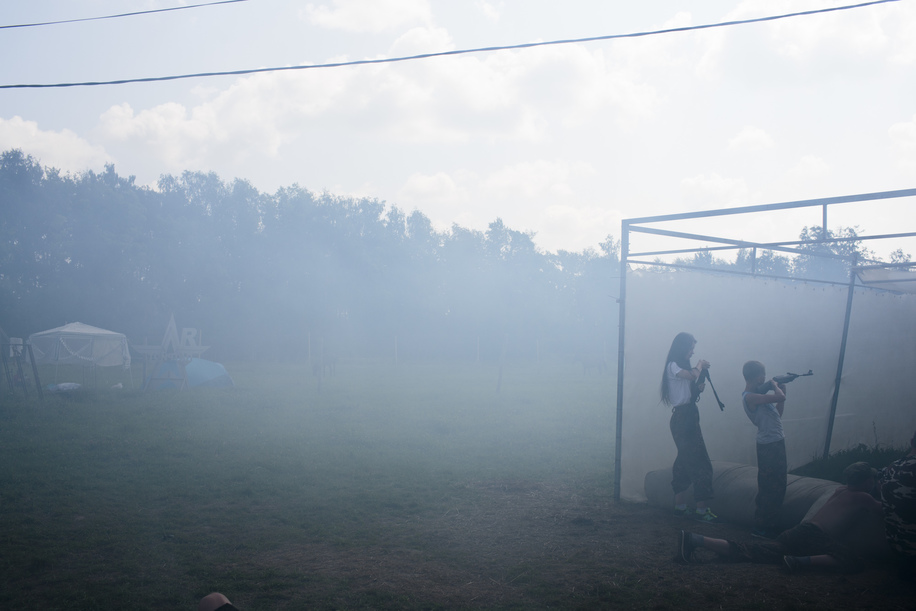

A fake grenade is launched, setting smoke in the atmosphere as students practice a drill with air-soft guns at the Historical-War Camp, in Borodino, Russia. 29 July 2016. They are using air-soft guns for the practice and competition. Students come from all across Russia to attend the camp, free of charge.
First Place Winner in SDN Call for Entries
Toy Soldiers
Sarah Blesener | Russian Federation
Photographer: Sarah Blesener
First Place Winner in SDN Call for Entries
Exhibit Title: Toy Soldiers
Location: Russian Federation
This is an ongoing project that I began in Russia in April of 2016, documenting rising nationalism amongst youth by focusing on patriotic education, military-war camps, and alternative groups for youth.
Over 200,000 youth in Russia are currently enrolled in patriotic clubs, with 10,000 in Moscow alone. Each club functions independently with their own structures and philosophies. In 2015, a proposed program from the Russian government entitled the “Patriotic Education of Russian Citizens in 2016-2020” called for an eight percent increase in patriotic youth within the next ten years, and a ten percent increase in new recruits for the Russian armed forces.
It is my aim to continue this projct in the United States in order to address issues of growing nationalism, and in order to start a larger conversation about these ideologies, and to understand how to combat intolerance.
On a Thursday afternoon, six teenage boys gathered in an abandoned warehouse in the town of Diveevo, Russia. Their instructor began to divide the group into teams and immediately the drills began. The group, called “The Survivalists,” meets weekly to practice tactical skills and defense strategies. Artyom, an older teenager of the group, was helping another student, Daniel, eleven-years old, to hide and prepare for a surprise attack with his plastic weapon in the corner room of the warehouse. Their instructor calmly tells me that their group is not looking for war, but they are preparing young patriots to be ready for the future.
Over 200,000 youth in Russia are currently enrolled in patriotic clubs, with 10,000 in Moscow alone. Each club functions independently with their own structures and philosophies. In 2015, a proposed program from the Russian government entitled the “Patriotic Education of Russian Citizens in 2016-2020” called for an eight percent increase in patriotic youth within the next ten years, and a ten percent increase in new recruits for the Russian armed forces.
There is nothing inherently wrong with patriotism. However, these two terms, nationalism and patriotism, easily blur, and patriotic rhetoric can lead to nationalistic thinking, the difference between these two terms being a shift from a devotion to a way of life or place to a feeling of superiority or aggression towards others that are different. I believe that youth are always easy targets and the easiest sources for spreading new ideologies, which is why I am focusing on patriotic education, clubs, camps, and alternative groups for youth. Combining patriotic education and gun training, mixed with fun and camaraderie activities makes the whole experience like a game.
The first chapter of this project was started in April of 2016 in various regions throughout Russia. However, I plan to expand the project in the United States, focusing on rising nationalism amongst youth. Nationalistic tendencies and biases are part of the make-up of most of us, whether we like it or not. However, I agree with George Orwell when he states, “whether it is possible to get rid of them I do not know, but I do believe it is possible to struggle against them.” In conversations about nationalism, it is easy to pin the topic on larger, more ‘extreme’ groups abroad, ignoring or otherwise being unaware of the issues we have in our own homes and countries.
While issues of rising nationalism amongst youth have been widely investigated in Europe and Russia, especially after the collapse of the communist rule and the end of the Cold War, the patriotic gap between generations in the United States has left this issue underreported. In November of 2016, the F.B.I reported a six percent increase in hate crimes since the prior year, with attacks against Muslim Americans seeing the largest increase. In 2015, 892 hate groups currently existed in the United States, which grew by fourteen percent since the prior year. There was also a fourteen percent increase in anti-government “patriotic” groups, such as militias in the same year. With the rise of alternate-right groups in the United States, an increase of hate-crimes and a growing rhetoric of xenophobia and fear, combined with the lack of research on youth and nationalistic sentiment, the current political climate has made this work a necessity for me.
It is my aim to address growing nationalism amongst youth in the United States, in an attempt to start a larger conversation about the causes of these ideologies, and to understand how to combat intolerance.
Sarah Blesener
+1 651 373 9709
contact@sarah-blesener.com
www.sarah-blesener.com
46 Fort Washington Ave, Apt 24
New York, NY, 10032
Make Comment/View Comments